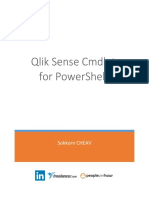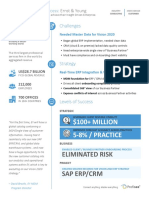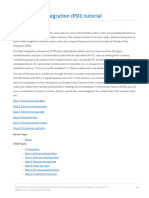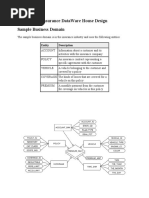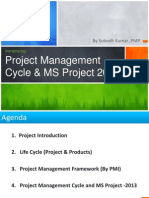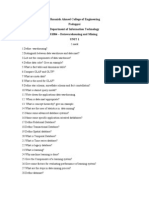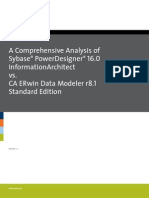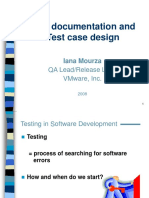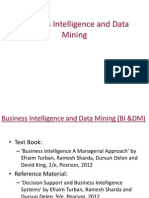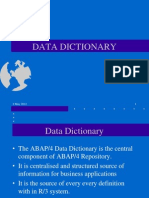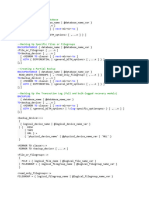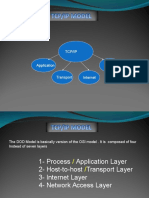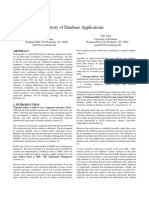Data Quality: You Don't Just Need A Dashboard!: by Peter Graham
Data Quality: You Don't Just Need A Dashboard!: by Peter Graham
Uploaded by
Eliot ManCopyright:
Available Formats
Data Quality: You Don't Just Need A Dashboard!: by Peter Graham
Data Quality: You Don't Just Need A Dashboard!: by Peter Graham
Uploaded by
Eliot ManOriginal Description:
Original Title
Copyright
Available Formats
Share this document
Did you find this document useful?
Is this content inappropriate?
Copyright:
Available Formats
Data Quality: You Don't Just Need A Dashboard!: by Peter Graham
Data Quality: You Don't Just Need A Dashboard!: by Peter Graham
Uploaded by
Eliot ManCopyright:
Available Formats
STRATEGY EXECUTION
Data Quality: You Don't Just
Need a Dashboard!
By Peter Graham
Peter would liiie to thank Brian Swarbrick of Palladium Figure 1: Gartner's Magic Quadrant for Data
Group for iois contribution to tiois column.
Quality Tools, 2007
T
hroughout this series, I have discussed how or- Challengers Leaders
ganizations can become information empowered,
Trillium Software
with an inherent assumption that it's accurate • • Business Objects
information. When this assumption is incorrect, • DataFlux
the results can be devastating: decisions made Group 1 Software • IBM
with poor or incomplete information can often
, FUZZY! Informatik • Informática
impact a company's bottom line more negatively than if the O
II I ^ •Human Inference
information were not presented at all. This month, I'll discuss % uniserv ^ Innovative Systems
how data quality issues occur and how your organization •DataMentors ,
Netrics • DataLever
can begin to identify and address them. Datanomic*
Data quality issues arise for a variety of reasons, includ- Datactics •
ing acquisitions of new data sources, poorly designed and
developed applications, and ironically business intelligence Niche Players Visionaries
(BI) implementations, where there can be focus on data pres- HCompleteness of Vision f
entation to the detriment of understanding information accuracy.
As of June 2007
The popular adage "you just need a dashboard" doesn't apply
anymore. A well-architected BI solution that enforces data in- Source: Gartner Inc., June 2007
tegrity and implements robust data quality procedures is a create a roadmap for enterprise data quality improvement.
requirement for any enterprise solution but should not be seen Depending on organization size, the data steward(s)
as a complete solution for the organization's data quality issues. should have complete responsibility for data quality gover-
Data quality is a business issue that transcends the entire organ- nance in his or her area. These gatekeepers must understand
ization, including operational systems. their respective systems, the quality of information across those
Gartner predicted that more than 50 percent of BI proj- systems and the implications of poor data quality. They
ects through 2007 would fail or receive lack of acceptance must be subject matter experts that provide direction anywhere
because of data quality issues.' TDWI estimated that customer their information is used and be the sole point of contact for
data quality issues alone cost U.S. businesses over $600 bil- all decisions related to the data they own. This data gover-
lion dollars a year.^ With the enactment of the Sarbanes-Oxley nance role should fall within the BICC if one exists.
(SOX) Act, quality of information is an ever-increasing pri- The rr organization should support the data quality improve-
ority. A clear initiative that focuses on the data quality ment initiative, ensuring effective implementation of processes
challenge is required to address this situation. and procedures and making supporting technologies available.
Data quality is a business issue, and business managers To assist IT in this endeavor, many vendors now offer soft-
should drive improvement. The first step in identifying data ware solutions that support enterprise data quality initiatives.
quality issues is to interview business users across the enterprise, Gartner now categorizes these data quality products as a sepa-
assessing their use of data and potential opportunities to improve rate commodity, although vendors offer several of the underlying
data quality. This assessment can be done using external re- components as standalone offerings (see Figure 1).
sources or leveraging roles from the business intelligence These tools help to identify, discover and improve data
competency center. The key to this assessment is to understand quality anomalies. Typically required for implementing qual-
business uses of data, therefore this requires an individual with ity BI applications, these products should also be used to
business expertise. Once this assessment is complete, the data should support data quality initiatives beyond a BI engagement.
be traced to its source systems to investigate the cause of poten- Typical functionalities available in these products include:
tial issues. From a BICC perspective, the data architect is often ' Data discovery: Quickly analyzes large volumes of data
most qualified to lead this investigation. While this investigation across different applications and provides statistics regard-
could be done through human evaluation of data and code, ing the data content (unique values, missing content, data
there are now many data discovery tools that evaluate data. Once formats, etc.). Analyses can be used to drive change back
documented, data quality opportunities should be prioritized based through the operational systems and BI applications.
on the perceived financial and operational impact, the resources ' Data cleansing: Integrates and cleanses customer data
required to address them and any project interdependencies to GRAHAM continued on page 37
36 August 2008 I DM Review www.dmreview.com
SCEALES and MORRIS continued from page 21 GRAHAM continued from page 36
flexibility to continue migrating while this is done. (primarily name and address data) from multiple sources and geo-
graphic locations for individuals and organizations.
Rule four: If you can't count it, it doesn't • Matching or householding: Groups individuals or organizations
count. Another challenge is how to meas- together for deduplication or to understand relationships, a task
ure data quality in order to assess the impossible to achieve without a robust data cleansing strategy.
state of your legacy data and determine ' Ongoing data quality monitoring: Tracks data quality improvements
the level of quality your business users over time.
require. To make matters worse, data quality • Master data management: Defines and maintains the data critical
is not static; it erodes and improves over time. It is to an organization's business processes.
important that the measures you use make sense to ' Integration with Bl and operational systems: Defines rules for improv-
business users and not just to technologists. This ing data quality that existing applications can integrate. Changes to
enables you to measure deliverabies, perform gap rules are automatically available to subscribers of that information.
analyses and monitor and improve ongoing data qual- To be truly successful, a data quality initiative must be adopted
ity. It also ensures that you are concentrating your across the organization, and there must be no barriers. With IT and
efforts on where business users see value and can business management working together, improvements in the qual-
quantify the benefits. ity of data can be adopted across the operational systems. Bl
Reconciliation of the data migrated from applications will also benefit from improvements in quality. Business
source(s) to target(s) is always a critical activity - decisions will become reliable, and in turn, impact on the bottom line
how do you know when you're done? When dealing will be positive. O
with dynamic environments where you can't freeze
the data, this becomes even more challenging; References:
1. "Gartner Identifies the 'Fatal Flaws' of Business Intelligence and Advises Organisations
you need to be able to handle a shifting scope. A on How to Avoid Them." Press Release from Gartnei; Inc., February 3,2005.
flexible data model and a closely coupled 2. "The Data Warehousing Institute's Recent Study Finds High Quality Data Is Critical To
reporting capability are key to understanding and The Success Of Businesses Worldwide." Press Release from TDWI, February 1,2002.
driving this process.
Peter Graham is the vice president ofthe tnformation Strategy and Architecture practice
at Palladium Group, Inc. He can be reached at pgraham@thepalladiumgroup.com.
Achieving a Business-Driven Migration
Having put a business-driven migration project in place,
the trick is to select methodologies and technologies that
can deliver against these requirements. A business-driven
migration involves decoupling the technical problem of
moving the data from the business processes that use it.
This requires a migration solution that enables you to
easily encapsulate the business problems you face while
being flexible enough to cope when those requirements
change. This ensures that ROI from new applications is AddressObject API
maximized and operations are enhanced rather than
adversely affected. Prevent errors before they occur to
The critical importance of getting the migration ensure the integrity of your database.
right from a business perspective was articulated at a
Use AddressObject API to verify,
recent British Computer Society meeting by BT's Phil
Dance: "Increasingly, our business case is going to cieanse and format customer data at
depend on how good we are at getting our data the point of entry or in batch. Address
across. A bad data migration ultimately means a bad Object easiiy integrates with Perl, PHP
customer migration, and in a competitive market, Java and .NET. - offering a better way
that's very bad news." O
to build-in data vaiidation.
References:
1. Phil Howard and Carl Potter. "Data Migration in the Global 2000 - The ability to maintain clean, reliable
Research, Forcasts and Survey Results." Bloor Research, September marketing data across multiple capture
2007. mediums is essential for everything we do
2. Phil Dance. "BT PIC's CIO for Technology." Data Migration - Kevin Parker, Digital Evergreen
Matters, November 2007.
Tony Sceales is CTO of third-generation migration technology vendor,
Celona Technologies. He may be reached at tony.sceates@celona.com.
John Morris is director of iergo ltd and author of Practicat Data
Migration (British Computer Society, 2006). He may be reached at
imorris@iergo.co.uk.
www.dmreview.com DM Review I August 2008 37
You might also like
- SystemVerilog ExercisesDocument3 pagesSystemVerilog Exercisespinakin4uNo ratings yet
- MIS609 Data Management and Analytics: Case Study ReportDocument10 pagesMIS609 Data Management and Analytics: Case Study ReportRaghavNo ratings yet
- High-Level Design (HLD)Document30 pagesHigh-Level Design (HLD)Gobara Dhan100% (1)
- Impact of Business Analytics and Enterprise Systems On ManagerialDocument16 pagesImpact of Business Analytics and Enterprise Systems On ManagerialMohamed LamrabetNo ratings yet
- DocXtractor II EnglishDocument39 pagesDocXtractor II EnglishIchsanul AnamNo ratings yet
- Non-Ferrous (NF) Metals Processing - SAP BlogsDocument16 pagesNon-Ferrous (NF) Metals Processing - SAP BlogsnabigcsNo ratings yet
- Human Capital Management (HCM) : SAP University Alliances Authors Claudia KroliczekDocument46 pagesHuman Capital Management (HCM) : SAP University Alliances Authors Claudia KroliczekTripta NairNo ratings yet
- NEODBDocument30 pagesNEODBMichel MüllerNo ratings yet
- Lecture 2 Data GovernanceDocument44 pagesLecture 2 Data GovernanceMecheal ThomasNo ratings yet
- Talend Open Studio For Master Data Management: A Practical Starter Guide 2nd EditionDocument100 pagesTalend Open Studio For Master Data Management: A Practical Starter Guide 2nd Editionsrini99No ratings yet
- Data Migration Write UpDocument5 pagesData Migration Write UpKousik MukherjeeNo ratings yet
- The Single Supervisory Mechanism (SSM) - The Big Data IssueDocument12 pagesThe Single Supervisory Mechanism (SSM) - The Big Data Issuecoco4444No ratings yet
- Magic Quadrant For Structured Data Archiving and Application RetirementDocument12 pagesMagic Quadrant For Structured Data Archiving and Application RetirementtangiprasadNo ratings yet
- Unit 1 Introduction To Business Intelligence (BI) Systems: StructureDocument24 pagesUnit 1 Introduction To Business Intelligence (BI) Systems: StructuregaardiNo ratings yet
- Qlik Sense Cmdlet For Powershell: Sokkorn CheavDocument11 pagesQlik Sense Cmdlet For Powershell: Sokkorn CheavIvan ShamaevNo ratings yet
- Bachelor of Science in Accountancy: Program Curriculum Ay 2020 - 2021Document6 pagesBachelor of Science in Accountancy: Program Curriculum Ay 2020 - 2021Rosemarie AngelesNo ratings yet
- OPEX Data Collection FY16Document1,531 pagesOPEX Data Collection FY16Anandbabu RadhakrishnanNo ratings yet
- COMP8047 - S03 Business RequirementsDocument30 pagesCOMP8047 - S03 Business RequirementsAlisha AprianyNo ratings yet
- $100+ MILLION 5-8% / PRACTICE: Eliminated Risk Sap Erp/CrmDocument1 page$100+ MILLION 5-8% / PRACTICE: Eliminated Risk Sap Erp/CrmParvathi ChandramohanNo ratings yet
- CRM FinalDocument54 pagesCRM FinalPrashant GuptaNo ratings yet
- Pentaho Data Integration (PDI) TutorialDocument33 pagesPentaho Data Integration (PDI) TutorialRif ManNo ratings yet
- Insurance DataWare House Design VechilesDocument2 pagesInsurance DataWare House Design VechilesSunil YogannaNo ratings yet
- SAP Master Data Governance, ConsolidationDocument54 pagesSAP Master Data Governance, Consolidationmanan.maheshwari298No ratings yet
- Project Management Cycle & MS Project 2013: by Subodh Kumar, PMPDocument26 pagesProject Management Cycle & MS Project 2013: by Subodh Kumar, PMPhardik4mailNo ratings yet
- Project Postmortem QuestionnaireDocument3 pagesProject Postmortem QuestionnairegridechNo ratings yet
- Decision Model & Notation (DMN)Document53 pagesDecision Model & Notation (DMN)Moataz BelkhairNo ratings yet
- FPA For Data WarehousingDocument25 pagesFPA For Data WarehousingdadongsNo ratings yet
- Data Warehousing ComponentsDocument5 pagesData Warehousing ComponentsVaishu SriniNo ratings yet
- CSE Image ProcessingDocument15 pagesCSE Image ProcessingGowtham Ambavaram0% (1)
- Sas AnalyticsDocument35 pagesSas AnalyticsprakashnethaNo ratings yet
- Adobe Analytics Dynamic Tag Management CourseDocument5 pagesAdobe Analytics Dynamic Tag Management CourseAureliuscsNo ratings yet
- Session 15-16 - BPMN ModellingDocument28 pagesSession 15-16 - BPMN ModellingPravish Khare100% (1)
- Greenplum A Hybrid Database For Transactional and Analytical WorkloadsDocument27 pagesGreenplum A Hybrid Database For Transactional and Analytical WorkloadsSICONG GONGNo ratings yet
- (Andrew Sears, Julie A. Jacko) Human-Computer InteDocument56 pages(Andrew Sears, Julie A. Jacko) Human-Computer InteBongani Lungile NamekoNo ratings yet
- Business Intelligence 101v1Document23 pagesBusiness Intelligence 101v1Rasmus SteffensenNo ratings yet
- Augmented Analytics EbookDocument17 pagesAugmented Analytics EbookMaria Madalina TurbatuNo ratings yet
- Functional Training PlanDocument15 pagesFunctional Training Planvopoxas967No ratings yet
- KNIME Versus AlteryxDocument4 pagesKNIME Versus AlteryxAnand ShivannaNo ratings yet
- Basic Concepts For Understanding Systems: Business Processes, Information, and Information SystemsDocument42 pagesBasic Concepts For Understanding Systems: Business Processes, Information, and Information SystemsKristineNo ratings yet
- DemystifyingThe Semantic LayerDocument13 pagesDemystifyingThe Semantic LayerSujit SadagopanNo ratings yet
- Dataware Q&a BankDocument42 pagesDataware Q&a BankSruthy Rajendhren100% (1)
- DEloitte InterviewDocument6 pagesDEloitte InterviewKarl AbiKaramNo ratings yet
- Big Data Analytics SyllabusDocument2 pagesBig Data Analytics SyllabusSaiyed Faiayaz WarisNo ratings yet
- Rubik Cube - CFOP Method - F2L Algorithms Cheatsheet A4 ColorDocument8 pagesRubik Cube - CFOP Method - F2L Algorithms Cheatsheet A4 ColorsefernetNo ratings yet
- Big Data Beyond The HypeDocument393 pagesBig Data Beyond The Hypey.b.ari.handoko.s3949No ratings yet
- Critical Capabilities For Field Service Management: Key FindingsDocument17 pagesCritical Capabilities For Field Service Management: Key FindingsMohammed Amine BenbahaNo ratings yet
- A Comprehensive Analysis of Sybase Powerdesigner 16.0 Informationarchitect vs. Ca Erwin Data Modeler R8.1 Standard EditionDocument44 pagesA Comprehensive Analysis of Sybase Powerdesigner 16.0 Informationarchitect vs. Ca Erwin Data Modeler R8.1 Standard EditionMayank ShekherNo ratings yet
- Top10 Critical Challenges BIDocument8 pagesTop10 Critical Challenges BIApolinar Arrieta RomeroNo ratings yet
- BI in FMCG Industry - Raj Basu: ©company ConfidentialDocument13 pagesBI in FMCG Industry - Raj Basu: ©company ConfidentialGaurav KarakotiNo ratings yet
- Test Documentation and Test Case Design: Qa Lead/Release Lead Vmware, IncDocument48 pagesTest Documentation and Test Case Design: Qa Lead/Release Lead Vmware, IncsysastroNo ratings yet
- DATA MiningDocument55 pagesDATA MiningAwadhesh YadavNo ratings yet
- TechM Offering Catalogues For RCG - VFDocument23 pagesTechM Offering Catalogues For RCG - VFAkshay AgrawalNo ratings yet
- Machine Learning, Deep Learning, and AI: What's The Difference?Document6 pagesMachine Learning, Deep Learning, and AI: What's The Difference?Shashwat ShuklaNo ratings yet
- Data DictionaryDocument11 pagesData DictionarySAP JOBS ForumNo ratings yet
- Decission Support SystemDocument7 pagesDecission Support SystemHaider SarwarNo ratings yet
- SAP SRM 7.0 - Self-Service ProcurementDocument32 pagesSAP SRM 7.0 - Self-Service ProcurementDjce YoNo ratings yet
- A Framework For Improving Key Performance Indicators Using Business Intelligence TechniquesDocument5 pagesA Framework For Improving Key Performance Indicators Using Business Intelligence TechniquesInternational Journal of Innovative Science and Research Technology100% (1)
- 4 - Process ModellingDocument34 pages4 - Process ModellingJake Blogger100% (1)
- BIGuidebook Templates - BI RequirementsDocument17 pagesBIGuidebook Templates - BI Requirementsnandex777No ratings yet
- Senior Management Policies: Organizational ChangeDocument10 pagesSenior Management Policies: Organizational ChangeAnonymous NnVgCXDwNo ratings yet
- Business Process Automation Tools A Complete Guide - 2020 EditionFrom EverandBusiness Process Automation Tools A Complete Guide - 2020 EditionNo ratings yet
- Chapter 3-Memory ManagementDocument40 pagesChapter 3-Memory ManagementArmoniem BezabihNo ratings yet
- T-SQL BackupDocument48 pagesT-SQL Backupkebe AmanNo ratings yet
- Hadoop PresentatonDocument46 pagesHadoop Presentatonohioprincess13No ratings yet
- 04 - 08 - 2021 Data Guard New Features and Best PracticesDocument106 pages04 - 08 - 2021 Data Guard New Features and Best Practicesrav1234No ratings yet
- Managing Code in The DatabaseDocument84 pagesManaging Code in The DatabaseranusofiNo ratings yet
- Locked ObjectsDocument4 pagesLocked ObjectsmyworldmyrulesNo ratings yet
- WWW Guru99 Com Informatica Interview Questions HTMLDocument17 pagesWWW Guru99 Com Informatica Interview Questions HTMLBinu SbNo ratings yet
- Clean LogDocument2 pagesClean LogcustodioliankennethNo ratings yet
- Parameters of The Command Prompt in Kaspersky Internet Security 2010Document9 pagesParameters of The Command Prompt in Kaspersky Internet Security 2010sameditzoNo ratings yet
- How To Gather Data For Openshift OVN-KubernetesDocument8 pagesHow To Gather Data For Openshift OVN-KubernetesSrinivasan100% (1)
- TCP IP ModelDocument13 pagesTCP IP ModelDevakumarNo ratings yet
- 1265 ID Identifikasi Pendapatan Asli Daerah Pad Kabupaten Kepulauan Sangihe Menuju PemekDocument8 pages1265 ID Identifikasi Pendapatan Asli Daerah Pad Kabupaten Kepulauan Sangihe Menuju PemekSentahanakeng Malahasa perkasaNo ratings yet
- PHP Output Buffering: SynopsisDocument7 pagesPHP Output Buffering: SynopsisveritasulNo ratings yet
- Module PoolDocument110 pagesModule PoolhjhggfgNo ratings yet
- SQL Server Database Administrator's Roadmap - Database Tutorials - DBA GuiaDocument9 pagesSQL Server Database Administrator's Roadmap - Database Tutorials - DBA GuiaAlexsander Martins dos SantosNo ratings yet
- Moving Payroll HCM Cloud Case StudyDocument33 pagesMoving Payroll HCM Cloud Case Studyhamdy20010% (1)
- HashingDocument25 pagesHashingsueana095No ratings yet
- Holykell 4800 Series RS485 ModBus Protocol V77Document9 pagesHolykell 4800 Series RS485 ModBus Protocol V77gregorymoreno.iemNo ratings yet
- UploadedFile - 2147483648Document46 pagesUploadedFile - 2147483648dhekle_dNo ratings yet
- Python Programming Unit 1 NotesDocument21 pagesPython Programming Unit 1 NotesAtebar HaiderNo ratings yet
- New Exer10Document2 pagesNew Exer10marilyn capuaNo ratings yet
- Wireshark 1Document3 pagesWireshark 1Ghani Adi NugrohoNo ratings yet
- Exercise 2Document4 pagesExercise 2Pardeep SinghNo ratings yet
- KLM E1sDocument4 pagesKLM E1sMinto Issac100% (1)
- Data Sheet MAXPRO NVR PE Professional EditionDocument3 pagesData Sheet MAXPRO NVR PE Professional Editiontest2012No ratings yet
- DB2 - An Introduction To Materialized Query TablesDocument9 pagesDB2 - An Introduction To Materialized Query Tablesapi-25919427100% (1)
- History of Database ApplicationsDocument4 pagesHistory of Database Applicationseyango1991No ratings yet
- SQL Experiment AnsDocument16 pagesSQL Experiment Ansprathuyendhe77No ratings yet














